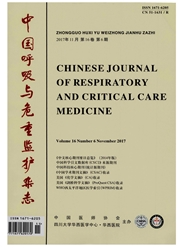

 中文摘要:
中文摘要:
目的评价Epworth嗜睡量表对OSAHS的筛查价值。方法以340例疑诊OSAHS患者为研究对象,均进行Epworth嗜睡量表(ESS)评分及多导睡眠图(PSG)监测,对其中48例患者的微觉醒指数进行人工分析。根据PSG监测结果患者分为非OSAHS组及轻、中、重度OSAHS组,比较四组间ESS评分及ESS评分≥9分患者所占比率的差异。利用受试者工作特征曲线(ROC)评价ESS评分对OSAHS的诊断价值。对ESS评分与患者的年龄、呼吸暂停低通气指数(AHI)、最低经皮血氧饱和度(LSpO2)、微觉醒指数之间进行相关性分析。结果ESS评分随着OSAHS病情的加重有逐渐增高的趋势(四组的ESS评分均数分别为:9.96±4.81、10.21±5.48、11.48±5.28和13.52±5.84),但只有重度OSAHS患者的ESS评分与其他组的差异有统计学意义(P〈0.05);各组的ESS≥9分患者所占的比率差异无统计学意义(P〉0.05);ROC曲线分析结果发现曲线下面积为0.601,且难以得出最佳诊断分值。ESS评分≥9分筛选OSAHS的灵敏度为70.0%,误诊率为64.9%。ESS评分与AHI存在低度正相关(r=0.240,P〈0.01),与LSpO2存在低度负相关(r=-0.198,P〈0.01),与年龄及微觉醒指数均无相关关系(P〉0.05)。结论ESS评分对重度患者的判断具有一定意义,但不能准确反映所有OSAHS患者的病情严重程度,以ESS≥9分来判定OSAHS病情并不可靠。ESS评分用于OSAHS病情的筛选与评价有其局限性,对OSAHS的筛查需要制定更加全面有效的评分系统。
 英文摘要:
英文摘要:
Objective To evaluate the value of Epworth sleepiness scale (ESS) in evaluating the severity of obstructive sleep apnea hypopnea syndrome (OSAHS). Methods A total of 340 cases with suspected OSAHS were enrolled. The ESS scores and polysomnography (PSG) monitoring data were analyzed. According to the PSG monitoring results the patients were classified into non-OSAHS, mild, moderate and severe OSAHS groups. The average ESS scores and the ratio of patients whose ESS score was ≥9 were compared among the four groups. The diagnostic value of ESS score was evaluated by ROC curve. The correlation of ESS scores with age,apnea hypopnea index ( AHI), the lowest SpO2 ( LSpO2 ) and microarousal index was analyzed. Results The ESS scores had an ascending tendency as the severity of OSAHS was increased but only in the severe OSAHS cases the difference was significant statistically compared with the other three groups ( P 〈 0. 05). The mean ESS scores in the four groups were 9. 96 ± 4. 81,10. 21 ±5.48,11.48 ±5.28 and 13.52±5.84,respectively. There was no statistical significance while comparing the ratio of patients whose ESS scores were ≥9 among the four groups. The analysis of ROC curve showed the area under the ROC curve (AUC) was lesser(0. 601 ) and a best cutoff could not be obtained. When ESS score ≥9 was made as the cutoff in screening OSAHS patients the sensitivity was 70. 0% and the misdiagnosis rate was 63.21%. The ESS scores had positive correlation with the apnea hypopnea index (AHI) (r = 0. 240, P 〈 0. 01 ) and negative correlation with LSpO2 (r = -0. 198,P 〈 0. 01 ). The ESS scores had no correlation with age or the microarousal index ( P 〉 0. 05 ). Conclusions The ESS score has some significance in screening severe OSAHS patients but can not exactly reflect the severity of OSAHS patients among Chinese population, suggesting ESS score has limited value in the evaluation of OSAHS severity. The ESS score ≥9 as a cutoff is not a reliable parameter to
 同期刊论文项目
同期刊论文项目
 同项目期刊论文
同项目期刊论文
 期刊信息
期刊信息
